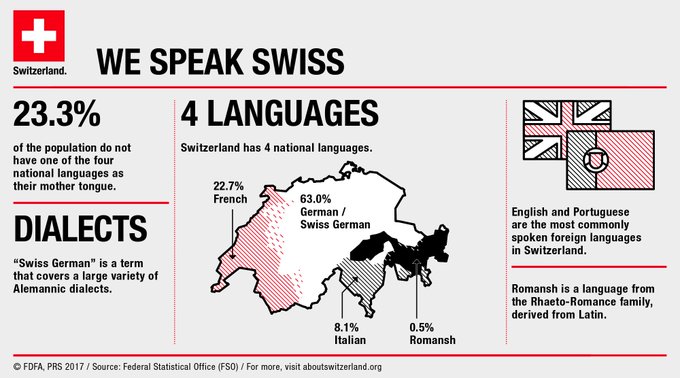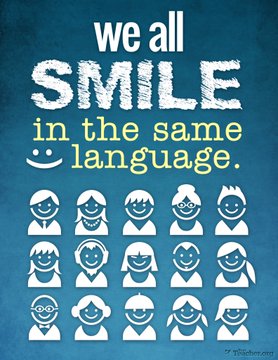“Never odd or even.” Why not start a blog post celebrating the beauty and oddities of language with an intriguingly perplexing phrase that is also a palindrome – a word or a sentence that reads the same backwards? First, my apologies in advance to anyone who suffers from a fear of palindromes, or what the Germans refer to as “Eibohphobie”, which is, in a deeply ironic twist, a palindrome itself! Okay, now on to what is already looking to be a higgledy-piggledy blog post originally designed to commemorate the September 26th European Day of Languages.
A day to celebrate language represents a fabulous or, borrowing from Mary Poppins, a supercalifragilisticexpialidocious opportunity. There are currently between 6,000 and 7,000 languages spoken among approximately 7 billion people. There are about 225 indigenous languages in Europe, representing about only 3% of the world’s total. Most of the world’s languages are spoken in Asia and Africa and at least half of the world’s population are bilingual or plurilingual.
The evolution of so many languages over the centuries has resulted in words that are especially descriptive and specific. For example, the Slovak word, prezvoniť, means to call someone’s mobile from your own without the other person picking up with the intention of leaving your number in their phone’s memory. The Albanian word, vetullhen, refers to an eyebrow arched like the crescent moon. The Dutch word, broodje-aap, refers to an awful, often invented story that is told as being true, thus becoming a myth. The Irish use the verb plubairnigh to describe the distinctive thick, bubbling sound that porridge makes when boiling. The Germans use the word, Zechpreller to describe the person who leaves without paying the bill. And, perhaps my favourite, the Finnish use the word poronkusema to describe the distance equal to how far a reindeer can travel without a comfort break (about 5 kilometres if you were wondering).
With the risk you may think this is all poppycock or, worse still, tarradiddle, let’s take a look at some tongue twisters that challenge our language skills.
English speakers may recall reciting this children’s song: She sells seashells by the seashore. The shells she sells are seashells, I’m sure. So, if she sells seashells on the seashore, then I’m sure she sells seashore shells.
How about this French tongue twister? Combien de sous sont ces saucissons-ci? Ces saucissons-ci sont six sous (How much are these sausages here? These sausages here are six cents).
Or, try this German tongue twister: Zwei schwarze schleimige Schlangen sitzen zwischen zwei spitzen Steinen und zischen (Two black slimy snakes sit between two pointed stones and hiss).
A Polish variation: Król Karol kupił Królowej Karolinie korale koloru koralowego (King Karl bought Queen Caroline coral-coloured bead).
And, finally, a Swedish tongue twister: Far, Får får får? Nej, inte får får får, får får lamm (Father, do sheep have sheep? No, sheep don’t have sheep, sheep have lambs).

Idioms also represent a deeply interesting aspect of language, usually highlighting cultural, historical, and traditional themes. By way of an example of how an idiom can span languages, all of the following idiomatic expressions are similar to “The apple does not fall far from the tree”:
- Æblet falder ikke langt fra stammen. (Danish)
- Der Apfel fällt nicht weit vom Stamm. (German)
- Nem esik messze az alma a fájától. (Hungarian)
- Obuolys nuo obels netoli rieda. (Lithuanian)
- Niedaleko pada jabłko od jabłoni. (Polish)
- Jabolko ne pade daleč od drevesa. (Slovenian)
- Äpplet faller inte långt från trädet. (Swedish)
Did you know that there is a word in the English language that describes the fear some people suffer from when they come across long words? The word for this phobia is hippopotomonstrosesquippedaliophobia. While it is in no way my intention to diminish the suffering anyone with this phobia experiences, it is hard to ignore the irony here given the length of this word! So, if you are a hippopotomonstrosesquippedaliophobic, please skip this next section as it will highlight some of the longest words found in languages.
- Hippopotomonstrosesquipedalianism (English word for the love of long words; 33 letters)
- ακτινοχρυσοφαιδροβροντολαμπροφεγγοφωτοστόλιστος (Greek word meaning to be dressed in golden-shining, thundering and incandescent clothes; 47 letters)
- Kindercarnavalsoptochtvoorbereidingswerkzaamheden (Dutch word related to the preparation activities for a children’s carnival procession; 48 letters)
- Speciallægepraksisplanlægningsstabiliseringsperiode (Danish word for the period when a specialist doctor’s planning of the practice is stabilized; 52 letters)
- Lentokonesuihkuturbiinimoottoriapumekaanikkoaliupseerioppilas (Finnish word for a technical warrant officer trainee specialized in aircraft jet engines; 61 letters)
- Grundstücksverkehrsgenehmigungszuständigkeitsübertragungsverordnung (German word for a regulation about competences; 67 letters)
Of a particularly impressive note, the Ancient Greek playwright Aristophanes coined the following 183 lettered word meaning a dish compounded of all kinds of dainties, fish, fowl and sauces:
Lopado-temacho-selacho-galeo-kranio-leipsano-drim-hupotrimmatosilphio-karabo-melito-katakechumeno-kichl-epikossuphophatto-peristeralektruon-opto-kephallio-kigklo-peleio-lagoio-siraio-baphe-traganopterugon
While these are fascinating and interesting language facts to consider, I should move beyond what some would consider my lollygagging and return to the motivation for this post – the celebration of language. While I am currently living in Europe and the European Day of Languages is certainly of great importance to the region, I would also like to extend the celebration to all languages and areas of the world when highlighting how important language is to our cultural heritage, to our understanding of ourselves and others, and to our ability to see and understand the world in different and new ways.

The International School of Zug and Luzern (ISZL) is fortunate to have Lorna Caputo as a member of its team serving as a language specialist and overseeing, among her other duties, 16 after-school language programs. In her blog, Exploring Multilingualism, Lorna highlights the importance of all languages:
It is the harmonious coexistence of languages that enables people to develop intercultural understanding, appreciate cultural diversity and work together better. Multilingualism is what unites many different regions within countries and is at the core of many national identities. Even in multicultural cities, you can observe local dialects and languages coexisting with other international languages. It is helpful to understand how schools can often be located within this linguistic intersectionality, and how schools prepare their students to navigate their familial, local, national and global linguistic landscapes.
Lorna will also be quick to discuss the research supporting the advantages associated with children learning multiple languages at a young age, which features an important aspect of her work with ISZL’s learning program.
In a note to community members this week, Lorna asked us to build on our recent inclusion work (see Inclusion & Community) and translate the phrase, “We are all ISZL” into their native language. Here are some of the wonderful responses:
- We are all ISZL (English)
- Мы все ISZL (Russian)
- Me ollaan kaikki ISZL (Finnish)
- Vi är alla ISZL ( Swedish )
- ISZL 我們是一家人 (Mandarin)
- Siamo tutti ISZL (Italian)
- Hepimiz ISZL’iz (Turkish)
- Wir sind alle ISZL (German)
- Nous sommes tous ISZL (French)
- Todos somos ISZL (Spanish)
- Tots som ISZL (Catalan)
- Somos todos ISZL (Portuguese)
- Wij zijn allemaal ISZL (Dutch)
- Mi mind ISZL vagyunk (Hungarian)
- Είμαστε όλοι ISZL (Greek)
- Mi smo svi ISZL (Serbian)
- Vi er alle ISZL (Danish)
In closing, I hope you didn’t find this post to be too higgledy-piggledy, but rather a supercalifragilisticexpialidocious experience! While my hope has been to highlight some of the interesting and unusual aspects of language, there is always the shadow of kakorrhaphiophobia, or the fear of failure, associated with this quixotic endeavour. There is a lurking feeling that perhaps I should have been more pauciloquent and that this text had been less argle-bargle in style, avoided goggledygook, and did not generate any bobsy-die. The last thing I want to do is to leave you bumfuzzled, frustrate you with the confusing “never odd or even” palindrome, or to diminish your status as a deipnosophist. Finally, I hope you don’t see me as a blatherskite, a hoddy-noddy, or a floccinaucinihilipilificator at heart!
Okay, this is probably enough tomfoolery, twaddle, and balderdash for today!
In the celebration and appreciation of all languages!
_____________________________________________
Some Definitions:
- Argle-bargle: copious but meaningless talk or writing
- Balderdash: senseless talk or writing
- Blatherskite: a person who talks at great length without making much sense
- Bobsy-die: a great deal of fuss or trouble
- Bumfuzzled: to be confused
- Deipnosophist: a person skilled in table talk
- Floccinaucinihilipilificator: the action or habit of estimating something as worthless
- Goggledygook: language that is meaningless
- Higgledy-piggledy: in confusion or disorder
- Hoddy-noddy: a foolish person
- Kakorrhaphiophobia: an irrational fear of failure
- Lollygagging: to spend time aimlessly
- Pauciloquent: using few words in speech or conversation
- Poppycock: nonsense
- Quixotic: extremely idealistic; unrealistic and impractical
- Tarradiddle: pretentious nonsense
- Tomfoolery: foolish or silly behaviour
_____________________________________________
Reference: The majority of the sources for this article are from the following website: https://edl.ecml.at/ (Take their language challenge: QUIZ)
Photo by Susan Holt Simpson on Unsplash

_____________________________________________
